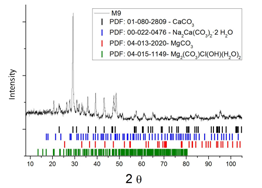- X-ray Diffraction -
Allows the chemical characterization of crystalline samples based on the diffraction of X-rays from their crystal lattice.
dating
morphology
technology
origin
composition
alteration

Ceramic

Metal

Mortar

Pigments

Stone
Ceramic Building Materials (CBM)
Possible to perform mineralogical characterization both of the matrix and the inclusions of CBM. The technique is used complementary to Optical Microscopy in order to detect mineral phases not visible by a microscope. The method yields information about the composition of the raw materials and can thus provide evidence on the technological know-how or their provenance and – with statistical treatment of the results – the diffusion of certain types of ceramic materials in a geographical area or in a chronological context (Stuart, 2007).
Metals & Alloys
By means of XRD the composition of metal corrosion products can be associated with the corrosion source and can help evaluate whether the patina protects or damages the metal.
Pigments
Applied for inorganic pigment identification of murals and frescoes and for the investigation of altered pigments due to weathering (Corbeil,2004).
Stone, Mortar & Plaster
Extendedly analysed with XRD (Biscontin et al., 2002; Genestar & Pons, 2003; Dotsika et al., 2009; Miriello et al., 2011). Mineralogical characterization of mortars allows their typological classification and provides evidence about their manufacture technology, whereas their comparison with samples of known origin can indicate the provenance of stone building materials or of the components of ancient mortars.
During stratigraphic investigations of buildings, XRD analysis can be employed to distinguish original from repair masonry or to identify previous consolidation treatments or restoration interventions.
Analysis of stone and mortar degradation products, e.g. encrustations on marbles or the presence of possible damaging secondary mineralogical phases, like
efflorescence* salts, can help understand the extent and source of degradation.
Useful tool to evaluate the efficacy of contemporary consolidation treatments.

XRD spectrum. Image by Nora Pérez Castellanos
X-ray diffraction is an analytical method* used for mineralogical identification of crystalline samples. The method consists in X-rays of a known wavelength getting diffracted* by a sample’s constituent crystals* in order to identify the nature, structure and concentration of the latter. XRD is applicable on any crystalline substance and is one of the most common methods used for the qualitative and quantitative characterization of Cultural Heritage materials.Produces a diffractogram, which is a spectrum* showing the diffraction angle and the intensity of the diffracted X-rays to be compared to spectral data from existing databases.
accuracy
time
cost
in situ
invasive
destructive
Crystalline substances are composed of crystal* lattices, which are three-dimensional geometric patterns of atoms or groups of atoms in ordered and symmetrical arrangements repeated at regular intervals keeping the same orientation to each other. When a monochromatic beam of X-rays strikes a crystalline sample, the X-rays are diffracted by the sample’s crystal* lattice, giving a unique pattern of “reflection” peaks at differing angles (which are a “fingerprint” of the crystals* they were diffracted by) and of different intensities (proportional to the concentration of the crystals* in the sample).